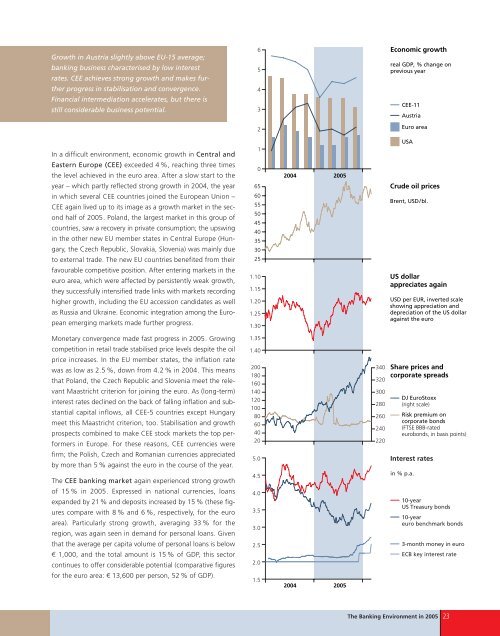team spirit - Bankier.pl
team spirit - Bankier.pl
team spirit - Bankier.pl
Create successful ePaper yourself
Turn your PDF publications into a flip-book with our unique Google optimized e-Paper software.
Growth in Austria slightly above EU-15 average;<br />
banking business characterised by low interest<br />
rates. CEE achieves strong growth and makes further<br />
progress in stabilisation and convergence.<br />
Financial intermediation accelerates, but there is<br />
still considerable business potential.<br />
In a difficult environment, economic growth in Central and<br />
Eastern Europe (CEE) exceeded 4 %, reaching three times<br />
the level achieved in the euro area. After a slow start to the<br />
year – which partly reflected strong growth in 2004, the year<br />
in which several CEE countries joined the European Union –<br />
CEE again lived up to its image as a growth market in the second<br />
half of 2005. Poland, the largest market in this group of<br />
countries, saw a recovery in private consumption; the upswing<br />
in the other new EU member states in Central Europe (Hungary,<br />
the Czech Republic, Slovakia, Slovenia) was mainly due<br />
to external trade. The new EU countries benefited from their<br />
favourable competitive position. After entering markets in the<br />
euro area, which were affected by persistently weak growth,<br />
they successfully intensified trade links with markets recording<br />
higher growth, including the EU accession candidates as well<br />
as Russia and Ukraine. Economic integration among the European<br />
emerging markets made further progress.<br />
Monetary convergence made fast progress in 2005. Growing<br />
competition in retail trade stabilised price levels despite the oil<br />
price increases. In the EU member states, the inflation rate<br />
was as low as 2.5 %, down from 4.2 % in 2004. This means<br />
that Poland, the Czech Republic and Slovenia meet the relevant<br />
Maastricht criterion for joining the euro. As (long-term)<br />
interest rates declined on the back of falling inflation and substantial<br />
capital inflows, all CEE-5 countries except Hungary<br />
meet this Maastricht criterion, too. Stabilisation and growth<br />
prospects combined to make CEE stock markets the top performers<br />
in Europe. For these reasons, CEE currencies were<br />
firm; the Polish, Czech and Romanian currencies appreciated<br />
by more than 5 % against the euro in the course of the year.<br />
The CEE banking market again experienced strong growth<br />
of 15 % in 2005. Expressed in national currencies, loans<br />
expanded by 21% and deposits increased by 15 % (these figures<br />
compare with 8 % and 6 %, respectively, for the euro<br />
area). Particularly strong growth, averaging 33 % for the<br />
region, was again seen in demand for personal loans. Given<br />
that the average per capita volume of personal loans is below<br />
€ 1,000, and the total amount is 15 % of GDP, this sector<br />
continues to offer considerable potential (comparative figures<br />
for the euro area: € 13,600 per person, 52 % of GDP).<br />
6<br />
5<br />
4<br />
3<br />
2<br />
1<br />
0<br />
65<br />
60<br />
55<br />
50<br />
45<br />
40<br />
35<br />
30<br />
25<br />
1.10<br />
1.15<br />
1.20<br />
1.25<br />
1.30<br />
1.35<br />
1.40<br />
200<br />
180<br />
160<br />
140<br />
120<br />
100<br />
80<br />
60<br />
40<br />
20<br />
5.0<br />
4.5<br />
4.0<br />
3.5<br />
3.0<br />
2.5<br />
2.0<br />
1.5<br />
2004 2005<br />
2004 2005<br />
340<br />
320<br />
300<br />
280<br />
260<br />
240<br />
220<br />
Economic growth<br />
real GDP, % change on<br />
previous year<br />
CEE-11<br />
Austria<br />
Euro area<br />
USA<br />
Crude oil prices<br />
Brent, USD/bl.<br />
US dollar<br />
appreciates again<br />
USD per EUR, inverted scale<br />
showing appreciation and<br />
depreciation of the US dollar<br />
against the euro<br />
Share prices and<br />
corporate spreads<br />
DJ EuroStoxx<br />
(right scale)<br />
Risk premium on<br />
corporate bonds<br />
(FTSE BBB-rated<br />
eurobonds, in basis points)<br />
Interest rates<br />
in % p.a.<br />
10-year<br />
US Treasury bonds<br />
10-year<br />
euro benchmark bonds<br />
3-month money in euro<br />
ECB key interest rate<br />
The Banking Environment in 2005 23
















